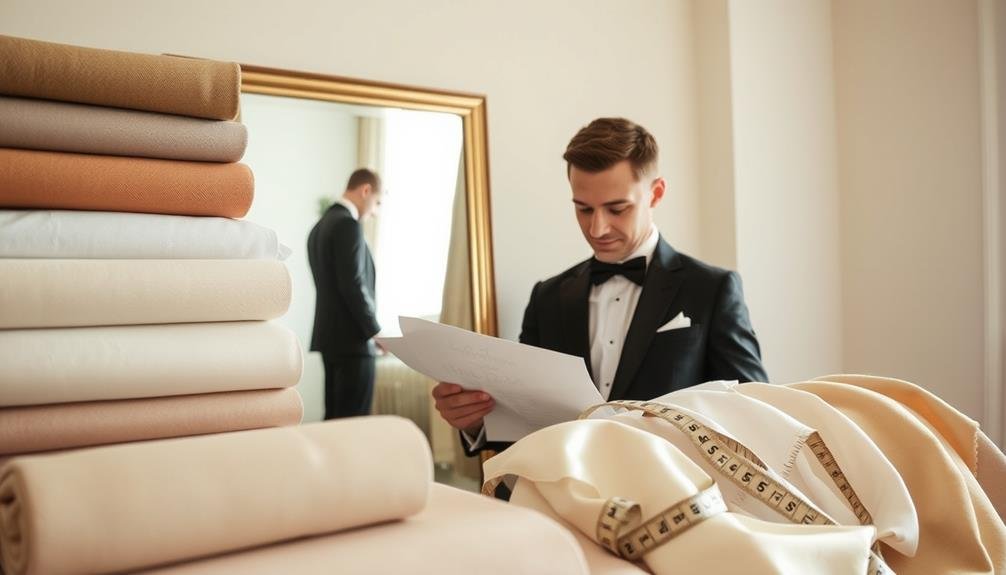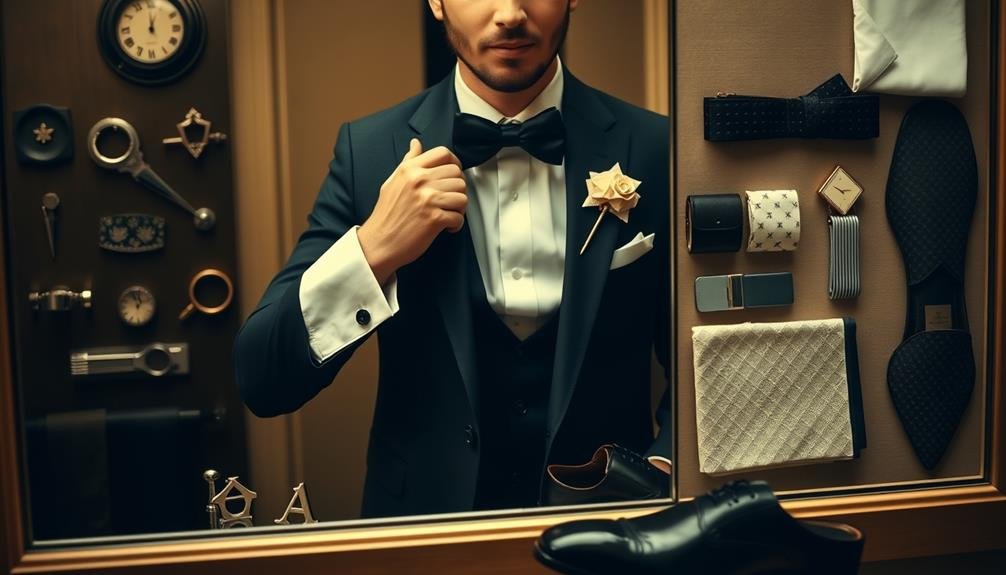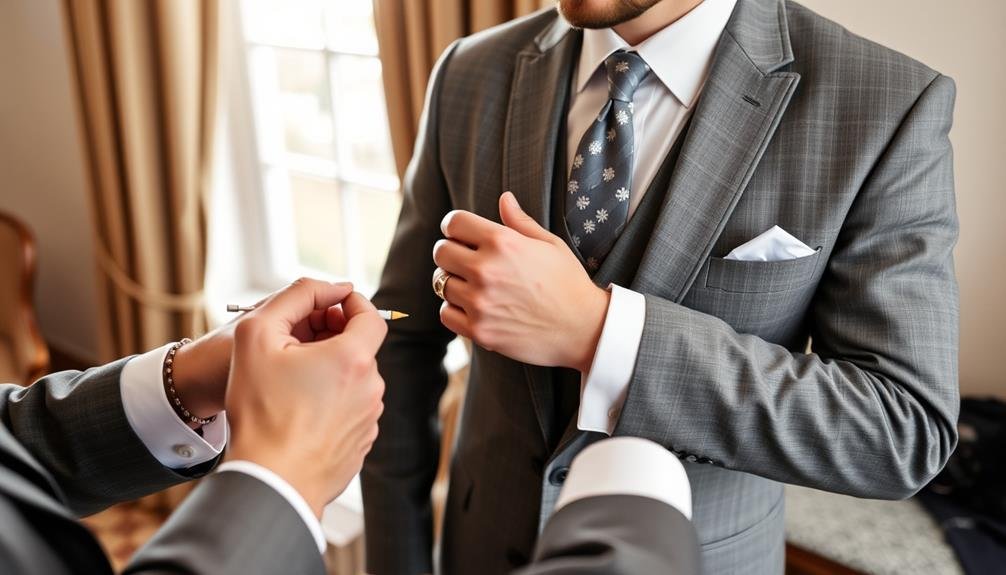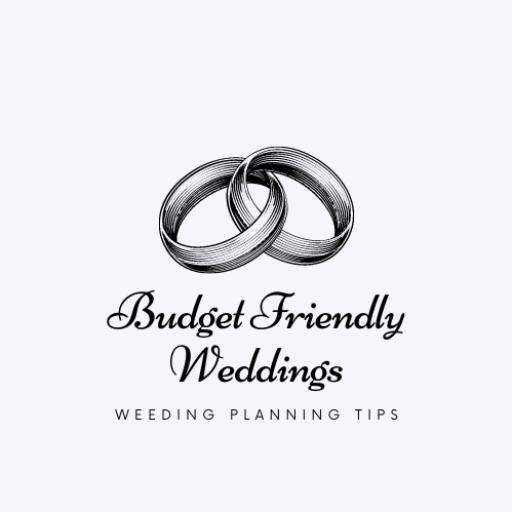Choosing the perfect wedding suit is an art that balances style, budget, and personal taste. You'll want to take into account your wedding's theme, venue, and season when selecting fabric and style. Set a realistic budget, factoring in hidden costs like alterations and accessories. Explore various suit styles, from classic single-breasted to trendy slim-fit options. Pick a color that complements your wedding scheme while remaining timeless. Guarantee a flawless fit with professional measurements and tailoring. Don't forget to accessorize with coordinating pieces like ties, pocket squares, and cufflinks. Start your suit search early to allow ample time for fittings and adjustments. The journey to finding your ideal wedding attire is just beginning.
Key Takeaways
- Consider the wedding style, venue, and season when selecting suit fabric, color, and formality level.
- Set a realistic budget, accounting for hidden costs like alterations and accessories.
- Choose a suit style that flatters your body type and aligns with your personal taste.
- Prioritize proper fit by getting accurate measurements and scheduling professional tailoring.
- Start shopping 3-4 months before the wedding to allow time for alterations and avoid rushed decisions.
Determining Your Wedding Style

Your wedding style sets the tone for your entire celebration, including your attire. To determine your wedding style, consider the venue, season, and overall theme you've envisioned.
Are you planning a formal black-tie affair, a rustic outdoor ceremony, or a laid-back beach wedding? Each of these settings calls for a different suit style.
For a traditional church wedding, you might opt for a classic tuxedo or a dark, formal suit. A countryside celebration could suit a tweed or linen ensemble, while a destination beach wedding might call for a light-colored, breathable fabric like cotton or linen.
Consider the time of day as well. Daytime weddings generally allow for lighter colors and more casual styles, while evening events tend to be more formal.
Don't forget to factor in the season – heavier fabrics for winter, lighter ones for summer.
Your personal style should also play a role. If you're fashion-forward, you might choose a trendy slim-fit suit or experiment with bold colors. If you prefer a timeless look, stick to classic cuts and neutral shades.
Setting a Realistic Budget
When planning your wedding attire, it's essential to establish a clear price range for your suit.
You'll want to take into account not just the cost of the suit itself, but also potential alterations, accessories, and dry cleaning.
Determine Your Price Range
Money matters when it comes to selecting your wedding suit. Once you've set a realistic budget, it's essential to determine your specific price range. This will help narrow down your options and prevent you from falling in love with a suit that's beyond your means.
Start by researching the average costs of wedding suits in your area. Consider factors like fabric quality, brand reputation, and customization options. Remember that off-the-rack suits are generally less expensive than made-to-measure or bespoke options. If you're looking for a high-end designer suit, be prepared to spend more.
Don't forget to factor in additional costs such as alterations, accessories, and dry cleaning. Set a firm upper limit and aim to find a suit within the lower to middle range of your budget. This will give you some wiggle room for unexpected expenses.
If you're on a tight budget, consider renting a suit or shopping during sales seasons. You might also find great deals at outlet stores or online retailers.
Consider Hidden Costs
Setting a realistic budget for your wedding suit involves more than just the price tag on the garment. You'll need to factor in several hidden costs that can greatly impact your overall expenses.
First, consider alterations. Even off-the-rack suits often require tailoring to achieve the perfect fit, which can add $50 to $200 or more to your total.
Don't forget about accessories like dress shirts, ties, pocket squares, and cufflinks. These items can quickly add up, potentially costing an additional $100 to $300.
If you're renting a suit, be aware of potential damage fees or late return charges. For purchased suits, factor in dry cleaning costs, both before and after the wedding.
You might also need special undergarments or shoes to complement your suit, adding another $100 to $300 to your budget.
Lastly, if you're planning multiple outfit changes or need a different suit for pre-wedding events, these additional garments will increase your overall expenditure.
Choosing the Right Fabric

Selecting the right fabric for your wedding suit is essential to both your comfort and appearance on the big day. The fabric you choose will affect how the suit drapes, breathes, and holds up throughout the event. Consider the season and venue when making your decision.
For summer weddings or tropical destinations, opt for lightweight, breathable fabrics like linen, cotton, or tropical wool. These materials will keep you cool and comfortable in warmer temperatures.
If you're getting married in cooler months or indoor venues, wool blends, flannel, or tweed offer warmth and sophistication.
Pay attention to the fabric's weight and texture. Heavier fabrics tend to hang better and create a more polished look, while lighter fabrics offer more flexibility and comfort.
Consider the suit's intended use after the wedding when choosing fabric durability.
Don't forget about the fabric's appearance. Smooth, fine-woven fabrics like worsted wool create a sleek, formal look, while textured fabrics like tweed or herringbone add visual interest and a more casual feel.
Remember that different fabrics take dye differently, so consider how your chosen color will look in various materials.
Exploring Suit Styles
When it comes to wedding suits, you'll find a variety of styles to choose from, each offering a unique look and level of formality.
The classic single-breasted suit features one row of buttons and a narrow overlap of fabric. It's versatile and flattering for most body types.
Double-breasted suits, with their overlapping front panels and two parallel rows of buttons, exude a more formal, sophisticated air.
For a sleek, modern look, consider a slim-fit suit. It hugs your body's contours and creates a sharp silhouette.
If you prefer a more relaxed fit, a traditional cut offers comfort without sacrificing style.
Tuxedos, characterized by satin lapels and a bow tie, are the epitome of formal wear and perfect for black-tie weddings.
Don't overlook three-piece suits, which include a matching waistcoat. They offer flexibility, allowing you to remove the jacket while maintaining a polished appearance.
For destination or summer weddings, linen or seersucker suits provide a lighter, more casual option.
Whatever style you choose, guarantee it complements your body type, personal taste, and wedding theme.
Selecting the Perfect Color

When choosing your wedding suit color, you'll need to decide between classic shades and trendier options.
Consider how your suit will complement the overall wedding color scheme.
It's important to strike a balance between personal style and timeless elegance that will look great in photos for years to come.
Classic vs. Trendy Colors
How do you strike the perfect balance between timeless elegance and modern flair when choosing your wedding suit color? It's a delicate decision that can greatly impact your overall look on your big day.
Classic colors like black, navy, and gray have stood the test of time for good reason. They're versatile, sophisticated, and complement a wide range of skin tones and wedding themes. Black exudes formal elegance, navy offers a rich, deep tone that photographs well, and gray provides a softer, more approachable option.
On the other hand, trendy colors can add a unique touch to your wedding ensemble. Burgundy, forest green, or even pastel shades can make a bold statement and reflect your personality. However, keep in mind that these colors may look dated in photos years down the line.
Consider your wedding's overall aesthetic, the season, and your personal style when deciding between classic and trendy colors. You can also strike a balance by opting for a classic suit color and incorporating trendy elements through accessories like ties, pocket squares, or boutonnieres.
This approach allows you to embrace current trends while maintaining a timeless foundation.
Complementing Wedding Color Scheme
With your wedding color scheme in mind, selecting the perfect suit color becomes a strategic decision. You'll want to complement, not clash with, the overall palette.
If you've chosen a neutral color scheme, you've got more flexibility. A classic black, navy, or gray suit will work well. For bolder wedding colors, consider a suit that picks up subtle tones from the palette.
Don't feel obligated to match exactly; instead, aim for harmony. If your wedding colors are deep burgundy and gold, a charcoal gray suit can provide a sophisticated contrast. For a beach wedding with blues and whites, a light tan or khaki suit might be ideal.
Remember, your suit should enhance the overall aesthetic, not compete with it.
Consider the season and venue as well. Darker suits tend to suit fall and winter weddings, while lighter shades work well for spring and summer.
If you're unsure, bring fabric swatches or color samples when suit shopping. This will help you visualize how different suit colors interact with your chosen palette.
Ultimately, the goal is to look polished and cohesive with your wedding's overall style.
Finding the Ideal Fit
The cornerstone of a great wedding suit is its fit. You'll want to guarantee your suit flatters your body shape and allows comfortable movement. Start by getting accurate measurements of your chest, waist, shoulders, arms, and inseam. These measurements will guide you in selecting the right size off the rack or opting for a custom-made suit.
When trying on suits, pay attention to key areas. The shoulder seams should align with your natural shoulder edge. The jacket sleeve should end at your wrist bone, revealing about half an inch of shirt cuff. The jacket's length should cover your rear and fall just past the curve of your buttocks.
For trousers, aim for a slight break at the shoe, with the hem brushing the top of your footwear. Consider your body type when choosing a suit style. Slim-fit suits work well for leaner builds, while classic fits can be more flattering for broader frames.
Don't hesitate to seek professional tailoring for adjustments. A well-fitted suit won't only look better but also boost your confidence on your big day.
Accessorizing Your Wedding Suit

Once you've secured the perfect fit, it's time to elevate your wedding suit with carefully chosen accessories. Your choice of accessories can make or break your overall look, so it's essential to select items that complement your suit and reflect your personal style.
Start with the basics: a crisp dress shirt and a well-coordinated tie or bow tie. The shirt should be impeccably pressed and fit comfortably, while the tie should complement the suit's color and style. Consider adding a pocket square for a touch of sophistication, ensuring it doesn't exactly match your tie but rather coordinates with it.
For a polished finish, don't forget these key accessories:
- Cufflinks: Choose a pair that reflects your personality or matches your wedding theme.
- Watch: Opt for a sleek, dress-style timepiece that doesn't overpower your suit.
- Belt: Select a leather belt that matches your shoes for a cohesive look.
- Shoes: Invest in high-quality dress shoes that complement your suit's color and style.
Timing Your Suit Purchase
Timing is essential when purchasing your wedding suit. You'll want to start shopping at least 3-4 months before your wedding date. This timeline allows for alterations, unexpected delays, and last-minute adjustments. If you're opting for a custom suit, begin the process even earlier, around 6 months in advance.
When you start early, you'll have the luxury of exploring various styles, fabrics, and colors without feeling rushed. You can also take advantage of seasonal sales or promotions, potentially saving money on your dream suit.
Here's a timeline to help you plan your suit purchase:
| Months Before Wedding | Action to Take |
|---|---|
| 6 months | Start researching styles |
| 5 months | Visit suit shops and get measured |
| 4 months | Place your order or make a purchase |
| 3 months | First fitting and alterations |
| 1 month | Final fitting and adjustments |
Alterations and Final Touches

Perfection lies in the details when it comes to your wedding suit. Once you've chosen your suit, it's time to focus on alterations and final touches.
Don't underestimate the importance of a well-fitted suit; it can make all the difference in how you look and feel on your big day.
Start by scheduling a fitting with a professional tailor. They'll guarantee your suit fits you like a glove, making necessary adjustments to the shoulders, sleeves, waist, and pant length.
Pay attention to the break of your trousers and the overall silhouette of the jacket.
Next, consider these final touches to elevate your wedding look:
- Choose a high-quality dress shirt that complements your suit
- Select the right tie or bow tie to match your wedding's style and colors
- Invest in well-polished dress shoes that are both stylish and comfortable
- Add subtle accessories like cufflinks, a pocket square, or a boutonnière
Frequently Asked Questions
Can I Wear a Tuxedo Instead of a Suit for My Wedding?
You can wear a tuxedo for your wedding. It's a classic, formal choice that'll make you look dashing. Just guarantee it fits well and suits your wedding's overall style. Don't forget to coordinate with your partner's attire.
How Do I Coordinate My Suit With the Wedding Party's Attire?
You'll want to coordinate with your groomsmen and bridesmaids. Choose a suit color that complements the bridesmaids' dresses. Match your groomsmen's attire to yours, but make sure you stand out as the groom.
Should I Buy or Rent My Wedding Suit?
You'll need to weigh your options carefully. If you'll wear the suit often, buying's a smart investment. Renting's more cost-effective for one-time use. Consider your budget, future plans, and personal style before deciding.
Are There Eco-Friendly Options for Wedding Suits?
Yes, you'll find eco-friendly wedding suit options. Look for suits made from organic cotton, recycled materials, or sustainable fabrics. You can also consider renting, buying second-hand, or choosing a versatile suit you'll wear again after the wedding.
How Can I Make My Wedding Suit Suitable for Future Formal Events?
You can choose a classic, versatile suit in a neutral color like navy or charcoal. Opt for timeless styles and avoid trendy details. Make certain it's well-tailored and high-quality. You'll be able to wear it for various formal occasions.
In Summary
You're now equipped to choose the perfect wedding suit that reflects your style and fits your budget. Remember to start early, consider your wedding's overall theme, and don't skimp on fit and quality. Whether you're going custom or off-the-rack, your suit should make you feel confident and comfortable. With these tips in mind, you'll walk down the aisle looking sharp and feeling great. Enjoy this special part of your wedding journey!

I’m Sarah, the creator and writer behind this site. I’m a wife and a mother of two wonderful kids who keep me on my toes and inspire me daily. My passion lies in creating and organizing memorable events and group activities, where people can come together and make lasting memories.





Leave a Reply